|
ROSE COTTAGE
Rose Cottage stood on the opposite side of the road from Culcavey
Stores. Tenants included a Mr & Mrs Colville who each year made an
effigy of Lundy, which was taken shoulder high to Hillsborough,
accompanied by Hillsborough Brass Band, and burned. Mr & Mrs Rutherford
occupied the cottage, followed by Bob and Bella Walker. Sadly the
cottage is gone, the only reminder being the gate to its entrance.
HARRY'S ROAD
Whilst the village of Culcavey was a small community made up mostly of
mill houses, there were other large houses in the area. Notably at the
top of Harry's Road were three such houses uniquely connected to the
village.
CULCAVEY HOUSE
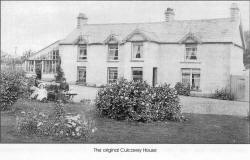 The use of the name `Culcavey House' can be confusing when looking at
the history of the area. To those who remember the gentleman's residence
bordering the Mill Pond on the Culcavey Road they immediately recall it
as Culcavey House or McBride's House. In fact this was the site of
Culcavey Cottage Farm, and when Herculese Bradshaw built his palatial
house in 1826 he coined the name `Culcavey House'. The original and real
Culcavey House stood at the top of Harry's Road on the right-hand side
and faced onto the Lisburn Road. Existing records show that this house
dates back to the early 1700's. The Nelson name has been associated with
the house since the 1750's. The original house stood on this site until
about 1912, when a new house built in front of it was named Brooklands.
The house still remains in Nelson hands, being the residence of Brian
Nelson and his family. Hubert Nelson (Brian's father), who was a forward
thinking and mechanically minded farmer, demonstrated the first Combine
Harvester (Allis Chalmers) to arrive in Northern Ireland in about 1942. The use of the name `Culcavey House' can be confusing when looking at
the history of the area. To those who remember the gentleman's residence
bordering the Mill Pond on the Culcavey Road they immediately recall it
as Culcavey House or McBride's House. In fact this was the site of
Culcavey Cottage Farm, and when Herculese Bradshaw built his palatial
house in 1826 he coined the name `Culcavey House'. The original and real
Culcavey House stood at the top of Harry's Road on the right-hand side
and faced onto the Lisburn Road. Existing records show that this house
dates back to the early 1700's. The Nelson name has been associated with
the house since the 1750's. The original house stood on this site until
about 1912, when a new house built in front of it was named Brooklands.
The house still remains in Nelson hands, being the residence of Brian
Nelson and his family. Hubert Nelson (Brian's father), who was a forward
thinking and mechanically minded farmer, demonstrated the first Combine
Harvester (Allis Chalmers) to arrive in Northern Ireland in about 1942.
WELLINGTON LODGE
Adjacent to Culcavey House stands Wellington Lodge. This house could
possibly have been built around the same time as Culcavey House.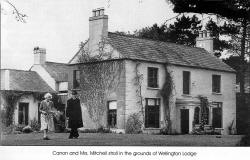 Records
indicate that the Rev. Edward Kent bought the house privately in around
1859. He was Rector of Annahilt until
1847 when he became Treasurer and Rural Dean of Dromore. Rev. Kent died
in London in 1863. The next recorded fact shows that Rev. Edward Smyth,
who was Rector of Rathfriland until 1873, lived in Wellington Lodge from
1873 until his death in 1876. From that date the Lodge became a Rectory
and was occupied by Rev. Stephen Campbell. Mr. Campbell's successor was
Rev FW Hogan, Vicar of Eglantine parish from 1882 to 1915. Canon AD
Mitchell followed Rev Hogan and remained in the house until his
retirement in 1961. The final ecclesiastical occupant of the house was
Canon F A Baillie. The house was sold in 1967 when a new modern rectory
was built beside All Saints' Parish Church Eglantine. Mr. Jeremy Bryson
occupied the house until 1998 when it was sold to the present owners. Records
indicate that the Rev. Edward Kent bought the house privately in around
1859. He was Rector of Annahilt until
1847 when he became Treasurer and Rural Dean of Dromore. Rev. Kent died
in London in 1863. The next recorded fact shows that Rev. Edward Smyth,
who was Rector of Rathfriland until 1873, lived in Wellington Lodge from
1873 until his death in 1876. From that date the Lodge became a Rectory
and was occupied by Rev. Stephen Campbell. Mr. Campbell's successor was
Rev FW Hogan, Vicar of Eglantine parish from 1882 to 1915. Canon AD
Mitchell followed Rev Hogan and remained in the house until his
retirement in 1961. The final ecclesiastical occupant of the house was
Canon F A Baillie. The house was sold in 1967 when a new modern rectory
was built beside All Saints' Parish Church Eglantine. Mr. Jeremy Bryson
occupied the house until 1998 when it was sold to the present owners.
It has always been the belief of the people of the surrounding area that
one of either of the above two houses was used as a staging post where
horses stopped via the Belfast to Dublin route.
EGLANTINE HOUSE
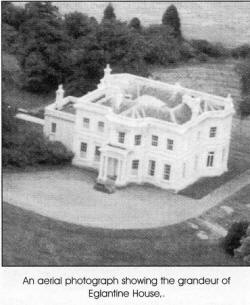 It is believed that Eglantine House was originally built by the Hill
Family, landlords of Hillsborough, pre. 1800. It may, like Kilwarlin
House, have been built for an unmarried daughter of the family to live
in! It is believed that Eglantine House was originally built by the Hill
Family, landlords of Hillsborough, pre. 1800. It may, like Kilwarlin
House, have been built for an unmarried daughter of the family to live
in! Mr Ambrose Moore, a civil engineer in charge of local roads, lived in
the house pre 1841. Moore's Bridge on Hillsborough Road Lisburn was one
of his constructions. In 1841 the Hill family sold Eglantine House to St
Clair Mulholland, the youngest of four brothers who owned the York
Street Spinning Mill in Belfast. At that time this mill was one of the
largest in the world and is now the site of the Yorkgate Shopping
Centre. After rebuilding and extending the house the family lived there
until 1917 when Miss Mary Mulholland, the last of St Clair Mulholland's
family, died. Mary was responsible for the building of All Saints'
Church, Eglantine, in 1875, as a memorial to her brother and father.
The Coulter family, still living in the area and one time owners of
the Newport Coal Quay, owned Eglantine House for a short time after 1917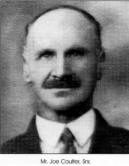 before it was sold with its 300 acre estate to Mr. Edward Thomas Green,
proprietor of ET Greens Mill near Belfast Docks. Around about 1973 the
Green family sold both the house and estate to Mr Anthony Skyrme,
before it was sold with its 300 acre estate to Mr. Edward Thomas Green,
proprietor of ET Greens Mill near Belfast Docks. Around about 1973 the
Green family sold both the house and estate to Mr Anthony Skyrme,
In the early 1980s the estate was divided into two farms and both
were sold. Two-thirds of the land and Eglantine House were bought by the
Falloon Family with the intention of converting the house into a hotel
or country club. However planning permission could not be obtained for
this project and the house lay mostly unoccupied until it was burnt down
on the night of Sunday 23rd September 1990. The very ornate front Gate
Lodge is still intact and lived in and is featured in The Gate Lodges of
Ulster published by The Ulster Architectural Heritage Society.
The other one-third of the land was bought by the Sloan Family who
have since built two large farm houses and many other buildings,
including a vegetable washing and bagging plant. Access to this farm is
by the former back avenue to Eglantine House, and this is also the way
into All Saints' Parish Church from Eglantine Road.

PUDDLEDOCK ROAD (now Aughnatrisk Road)
In addition to the two row of Mill Houses (Thompson's Row and Puddledock
Row) there were other houses of note on this road.
BRICKFIELD LODGE
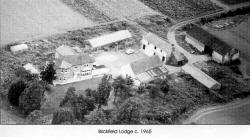 This property was aptly named, as it was here during the 17th and 18th
century bricks were made from the clay deposits so suited for that
purpose. The kneaded clay would have been made into bricks and laid
horizontally to be hardened by the heat of the sun (sun baked). Kiln
drying came into general use around 1700. The Lodge was re-named
Brickfield Cottage, and at the turn of the century was owned by a Mr
Greer, who in 1913 emigrated to Canada. The property was purchased by a
Mr Adams who whilst farming the land also operated a Saw Mill. He also
enhanced the property by creating a grass tennis court. The next
occupant was Mr Hood, who from 1939 specialised in market gardening. The
Northern Ireland Electricity Supply Depot, Aughnatrisk Road, is now
located on the site of Brickfield Lodge, and Lagan Valley Steel also
occupies part of the farm land. This property was aptly named, as it was here during the 17th and 18th
century bricks were made from the clay deposits so suited for that
purpose. The kneaded clay would have been made into bricks and laid
horizontally to be hardened by the heat of the sun (sun baked). Kiln
drying came into general use around 1700. The Lodge was re-named
Brickfield Cottage, and at the turn of the century was owned by a Mr
Greer, who in 1913 emigrated to Canada. The property was purchased by a
Mr Adams who whilst farming the land also operated a Saw Mill. He also
enhanced the property by creating a grass tennis court. The next
occupant was Mr Hood, who from 1939 specialised in market gardening. The
Northern Ireland Electricity Supply Depot, Aughnatrisk Road, is now
located on the site of Brickfield Lodge, and Lagan Valley Steel also
occupies part of the farm land. LAURELVALE
This was the home of the McCandless family and the farm remained in
their name up to 1930. It was here that Rex and Cromie McCandless, the
motor cycle legends, were born. Mr. John Law became the next owner and
continued to farm the land. The Law family remain in residence, and the
area around the farm has been industrially developed. Bertie Emerson
recalls how his Grandfather McCandless, once a year, drove his horse and
cart from Laurelvale Farm along a track over the hills to the 'Flush' at
Reilly's Trench and back again in order to keep the right of way open.
DICK'S HUT
This was a small wooden structure that stood on the right-hand side past
Culcavey crossroads. Originally built in the early 1930's as a lock-up
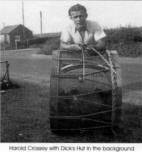 shop to distribute newspapers, it was operated by Mr Harry Ginn from
Hillsborough. When he ceased business it was taken over by Mr Dick
Thompson, and at that time another smaller hut was added to provide
living accommodation. The shop was mainly a confectioners/ tobacconists
and also carried out the vital function as newsagent, as Culcavey Stores
did not operate this service. As a newsagent it meant the shop was open
at night and over the weekend. The Stores closed at lunch time on
Saturday. The building was quite small, and people often wondered how
Dick, as he was always known, managed to live in it. Here the village
children would spend their pennies at the weekend, while the adults
bought cigarettes and newspapers. Dick carried on trading in his `hut'
for a good number of years until his retirement to a nursing home in
Holywood, Co. Down. His avid interest was horse racing and he proclaimed
to know many people in the racing world. People will remember him as one
of the `characters' of village life. shop to distribute newspapers, it was operated by Mr Harry Ginn from
Hillsborough. When he ceased business it was taken over by Mr Dick
Thompson, and at that time another smaller hut was added to provide
living accommodation. The shop was mainly a confectioners/ tobacconists
and also carried out the vital function as newsagent, as Culcavey Stores
did not operate this service. As a newsagent it meant the shop was open
at night and over the weekend. The Stores closed at lunch time on
Saturday. The building was quite small, and people often wondered how
Dick, as he was always known, managed to live in it. Here the village
children would spend their pennies at the weekend, while the adults
bought cigarettes and newspapers. Dick carried on trading in his `hut'
for a good number of years until his retirement to a nursing home in
Holywood, Co. Down. His avid interest was horse racing and he proclaimed
to know many people in the racing world. People will remember him as one
of the `characters' of village life.
RAILWAY VIEW
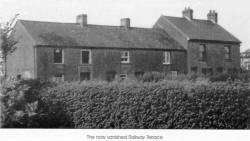 Just past Oakmount, the red brick residence of the Emerson family (built
in 1913), a lane-way led to five two-storey houses called Railway View.
Very aptly named, the railway line faced them just one field away.
Originally a two storey stone built farmhouse stood on this agricultural
holding, and in the 1880's Mr Shaw of Culcavey Stores owned it. This was
made into three cottar-houses (dwellings for farm labourers) and in the
1930's two houses were built onto the northern gable. Each of these
houses had a garden. Bertie Emerson recalls that they were built on a
clay base rendering them completely free of damp. Tenants names were
Carr, Crossey, Cunningham, Dewart, Hunter, McAdam and McDonald. Just past Oakmount, the red brick residence of the Emerson family (built
in 1913), a lane-way led to five two-storey houses called Railway View.
Very aptly named, the railway line faced them just one field away.
Originally a two storey stone built farmhouse stood on this agricultural
holding, and in the 1880's Mr Shaw of Culcavey Stores owned it. This was
made into three cottar-houses (dwellings for farm labourers) and in the
1930's two houses were built onto the northern gable. Each of these
houses had a garden. Bertie Emerson recalls that they were built on a
clay base rendering them completely free of damp. Tenants names were
Carr, Crossey, Cunningham, Dewart, Hunter, McAdam and McDonald. On the
opposite side of the road to the entrance of Railway View stood a
whitewashed cottage. In the 1930's the Crothers family occupied this
cottage. Mr Crothers worked for the Belfast and County Down Railway, and
in the evening carried on a bicycle business. Members of the family
joined the armed services and one daughter emigrated to the USA. During
the 1950's the cottage became home to the village cobbler (shoemaker)
Mr. Dewart. The owner of the cottage, Mrs Hewitt, had the building
`taken down' and a new bungalow built in its place.
 CULCAVEY HALL
ASSEMBLY
Previous to the erection of the first building known as `Culcavey
Mission Hall' gospel meetings were held in an old school building
belonging to the Hillsborough Linen Company as far back as 1919. Some
time later a Sunday school was started in the Halftown Orange Hall and
later a gospel and a prayer meeting followed. Those involved in this
work were George McCord, Joseph Coulter and Robert Smith, and they
decided that a permanent building was needed, so a wooden structure was
bought from the brethren of Windsor Gospel Hall in Belfast.
The trust
deed then drawn up showed Messrs G McCord, E Woods, D Patterson, S Greer
and J Scandrett as trustees placing upon them no other obligation but
that the building would be used only for evangelical meetings. The land
deed showed that George McCord had transferred this plot of ground to
the trustees free of charge. All these events took place around 1929.
The Worship meeting or breaking of bread commenced in 1930. Much support
was given by the Belfast's Victoria Hall Assembly and by various other
churches. Attendances were large, with missions being taken by Mr Tocher
of Belfast's Templemore Hall and a Scotsman, Mr James McKendrie. Most
of the children in the village attended the Sunday school, where in the
I940s the principal was Mr Bobbie Smith. The teachers were the
Pattersons, the Greers, Mr Porter and Mr Thompson. Excellent Christmas
parties were organised and an invitation was even extended to those who
did not attend the Sunday school. By the mid-1950s the old wooden hall
was beginning to show signs of decay, so it was given a front and a back
of brick, leaving the timber hall in between. In the 1960s a donation of
�500 was made by the Sir John Laing Fund to complete the building work
commenced in the previous decade. A new hall was in effect built and
linked with the brick front and back walls. During the work meetings
were held in a tent loaned by a Mr Glasgow of Newtownards. Further
renovation work was carried out in the I980s to provide what is now a
very modern and fitting place in which to preach the word of God.
NEWPORT HOUSE
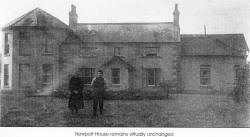 Down past the `Mission Hall' the road traverses to the left leading down
the back of the new Newport Primary School. This was the original road
before the M I was built. To the back of the school stands Newport
House. The present owners are the Reid family. Down past the `Mission Hall' the road traverses to the left leading down
the back of the new Newport Primary School. This was the original road
before the M I was built. To the back of the school stands Newport
House. The present owners are the Reid family.
The property has been beautifully and traditionally maintained over the
years, and acres of arable land bordering the canal were attached to it.
The farm took on a new importance when the canal was built, with a
spacious yard and a range of out buildings the advantages were clear.
Here a store (shop) was built, and a weigh-bridge for horse-drawn
vehicles was installed. A private quay was built on the feeder river to
the canal. The entrance to this quay, which was for private and
commercial purposes, was straight through the farmyard. It is recorded
as being in use in 1853. Many of the original features of the house
can be seen today. A most beautiful specimen of a weeping willow is
still growing on the front lawn, reminiscent of bye gone days.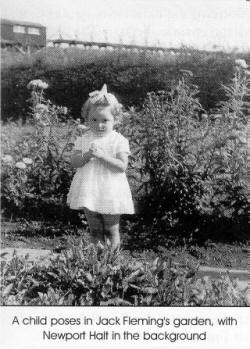
NEWPORT RAILWAY HALT
From Newport House you would have looked directly across the fields to
the front to see Newport Railway Halt. The Halt was specially
constructed during World War II to facilitate Service personnel
stationed at Long Kesh, and remained in operation right up until the
line was closed. Many will remember Mr Arthur Dowd who was in charge of
the Halt.
 ALL SAINT'S PARISH CHURCH, EGLANTINE
Today Culcavey falls within the Church of Ireland parish of Eglantine,
although this was not always the case. Originally, this was within the
boundary of the parish of Hillsborough and then of Lisburn Cathedral,
and latterly of Christ Church, Lisburn. In 1875 the independent parish
of All Saints, Eglantine, came into being. The parish area stretches
from Sprucefield to Carnreagh and from Ravarnet to Maze. The name,
Eglantine, is French Norman and means Dog Rose. It is uncertain how this
name came to be associated with this area, although we know that the
Normans were not too far away at Duneight.
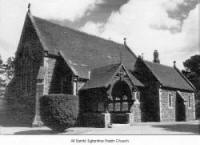 The present beautiful
church was consecrated by Bishop Robert Knox on 15 July 1875 and was
designed by Sir Thomas Drew. He was an architect of some renown and his
other works include St Anne's Cathedral in Belfast. All Saints was not
actually built to serve as a parish church, but rather as a private
chapel for the Mulholland family of Eglantine House. The prime mover in
building the house was Mary Mulholland, who wished it to be a memorial
to St Clair Kelburn Mulholland and his young son, also named St Clair.
The elder Mulholland was one of five brothers who founded the York
Street Spinning Mills in Belfast. The family, which retained its
connection with the parish until 1917, is remembered in the stained
glass east window of the church. The present beautiful
church was consecrated by Bishop Robert Knox on 15 July 1875 and was
designed by Sir Thomas Drew. He was an architect of some renown and his
other works include St Anne's Cathedral in Belfast. All Saints was not
actually built to serve as a parish church, but rather as a private
chapel for the Mulholland family of Eglantine House. The prime mover in
building the house was Mary Mulholland, who wished it to be a memorial
to St Clair Kelburn Mulholland and his young son, also named St Clair.
The elder Mulholland was one of five brothers who founded the York
Street Spinning Mills in Belfast. The family, which retained its
connection with the parish until 1917, is remembered in the stained
glass east window of the church. The completed church cost �3,442 5s
10d and is a fine example of Early English style gothic, built of
blackstone with sandstone dressings. A pleasant feature of the exterior
is the turret with its three little bells. The interior is equally
rewarding, with a font and pulpit carved from French Caen stone. The
building is composed of a nave and south aisle with a very
English-looking carved timber porch. In 1943 the Rector of the church
was approached by the Imperial War Graves Commission seeking permission
to have a number of grave spaces reserved for the use of the air forces
stationed at RAF Long Kesh. As a result of this arrangement, twenty-one
airmen of different ranks and faiths from the Royal Air Force, Royal
Canadian Air Force, Royal Australian Air Force and the Royal New Zealand
Air Force are buried here.
THE LAGAN CANAL
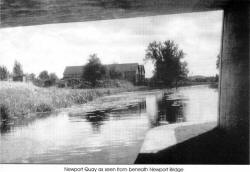 The Lagan Canal was constructed in 1794 to give barges or lighters a
watercourse from Belfast to Lough Neagh. The River Lagan was navigable
as far as Lisburn, but required engineering work to extend that course.
From Moore's Bridge at Lisburn the sloping ravine made a natural setting
for the canal and facilitated its construction. The river was lower than
the canal and required four locks to transfer boats from one level to
another. Following the pathway along this stretch of canal form the
Union Locks at Lisburn, under the hump-backed Blaris Bridge to Kesh
Bridge, were to be found structures that were part and parcel of
canal-building, such as locks, quays, culverts, excavations and
embankments. The towpath gave the residents of Culcavey a short cut to
Lisburn and Maze. The Lagan Canal was constructed in 1794 to give barges or lighters a
watercourse from Belfast to Lough Neagh. The River Lagan was navigable
as far as Lisburn, but required engineering work to extend that course.
From Moore's Bridge at Lisburn the sloping ravine made a natural setting
for the canal and facilitated its construction. The river was lower than
the canal and required four locks to transfer boats from one level to
another. Following the pathway along this stretch of canal form the
Union Locks at Lisburn, under the hump-backed Blaris Bridge to Kesh
Bridge, were to be found structures that were part and parcel of
canal-building, such as locks, quays, culverts, excavations and
embankments. The towpath gave the residents of Culcavey a short cut to
Lisburn and Maze. Culverts had to be built to take the field drains as the canal was
higher than much of the countryside. A lattice work iron bridge was built
over the canal near Newport in 1863 to accommodate the Great Northern
Railway line. A stone pillar on a concrete base at the Culcavey side of
the canal helped to support this great structure. At this particular
point the canal was wider than usual and then it narrowed to a 45 degree
angle to flow under the low Newport Bridge. At the Kesh side of this
bridge it was again wider in order to accommodate two barges passing
each other. There was also berthing for several barges bow to stern near
the quay and three brick-built coal sheds.
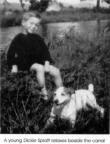 Further along at the junction of the feeder river (the Whiskey River)
the original course of the river was blocked, although a new outlet had
been dug at right angles one hundred yards back. This area was called
the `Cutts' and its design prevented sediment from the feeder river from
entering the canal. Further along at the junction of the feeder river (the Whiskey River)
the original course of the river was blocked, although a new outlet had
been dug at right angles one hundred yards back. This area was called
the `Cutts' and its design prevented sediment from the feeder river from
entering the canal.
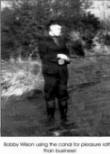 The canal was completed in 1794, making the
transport of goods and particularly heavy goods, much easier, and the
new port or `Newport' benefited from this with the opportunities
provided for the distillery and linen factory in bringing in raw
materials and transporting finished items. The canal was completed in 1794, making the
transport of goods and particularly heavy goods, much easier, and the
new port or `Newport' benefited from this with the opportunities
provided for the distillery and linen factory in bringing in raw
materials and transporting finished items. The Newport Bridge was
built in 1794 and it was accustomed to traffic of one or two horsepower
and perhaps only experienced heavy usage when the local lord passed over
it in his coach and four. Increased traffic down the years took its toll
on the bridge and part of its retaining wall collapsed during the Second
World War. The army built a temporary iron bailey bridge, which in turn
was replaced by a concrete structure. When the M I motorway was built a
new bridge was provided on the realigned Culcavey/Halftown Road.

NEWPORT SCHOOL
Elementary education in Britain was made compulsory from 1876. Newport
Public Elementary School was built in I870 at the junction of the
Halftown Road and the Lagan Canal. This building still exists in use as
a nursery school. It was very typical of the time, being built of red
brick with a steep slated roof with high windows and a schoolmaster's
residence attached. The large hall inside the building was divided into
two classrooms. At that time all religious denominations had their own
school and Newport was under the control of the Church of Ireland. This
link was made very clear in 1909 when a new principal was being sought,
as applicants had to be prepared to additionally serve as organist and
choirmaster at All Saints, Eglantine.
Mr JJ Victor Boyd was appointed at this time and he
served as principal for 36 years. A memorial in All Saints' Eglantine
Church is a record of Mr. Boyd's contribution to the education and
musical life of the area.
Church control of the school remained until it was
transferred to the Down County Council Education Committee in 1927. In
1930 there was a proposal to amalgamate the two Maze schools and
Newport, although in the event only the Maze schools were linked.
With the proximity to RAF Long Kesh, the classrooms
were used by servicemen for training in the evenings between 7 and 9 pm,
and the evacuees placed in the area due to the war served to increase
numbers on the school register. After the war numbers moving into the
area increased and the need for a new larger school building became
apparent. A new school was completed in November 1967 and was dedicated
on 3 January 1968. The growth of the school at this time is indicated by
the appointment of the first ever vice-principal, Mrs FE Brown. This
flurry of activity was also mirrored by the formation of a Parent
Teacher Association.
However, by the time the school came under the
jurisdiction of the South Eastern Education and Library Board in 1972
enrolment was in decline. Anyone familiar with the area today will know
that this is definitely not the case now with the vastly increased
numbers ofhouses in the vicinity.
For the many children who passed through Newport
School their memories of school life include the names of their
teachers. As the Principal (in earlier years known as Headmaster) is
usually the one brought most easily to mind, many people will remember
who `ran the ship' in their schooldays. Following Mr Boyd we have:
- Mr Frederick W. Browne
- Mr Harry Chasty
- Mr Harry Carson
- Mr Ronald Wilson
- Mr Ronnie Small
- Mr Derek Henderson
- Mrs Ruth Dodds
- Mrs Margaret Wilson
Mrs Barbara Lewers (nee Clarke) � current Principal
The following teachers too will evoke memories,
although the list isn't comprehensive, but does include today's staff,
with Mrs Lewers and Miss McGowan having chalked up thirty-six years of
teaching at Newport between them:
|
Mrs FE Browne |
|
Mrs Helen Turner |
|
Miss A Duff |
|
Mrs Muriel Kinley |
|
Miss Mary Doak |
|
Mrs Christine MacKenzie |
|
Mrs Hillman |
|
Mr Andrew Brown |
|
Miss Patterson |
|
Miss Janet McGowan |
|
Miss Kelly |
|
Mrs. Eleanor Turnbull |
|
Mrs. Heather Campbell |
|
Miss Cheryl Magill (now Mrs. McCormick) |
|
Miss Grace Dickson (now Mrs.Kerr) |
|
Mrs. Linda Crean |
|
Miss J McKibben |
|
Mrs. Ruth Bennett |

Day trips, overnight visits and longer trips both on
the mainland and across the water became a feature of school life. Cabra
Towers, London, Edinburgh and the Lake District evoke memories. How
different school was in the 1920's as Bertie Emerson recalls:
To school from Culcavey the six members of the
Emerson family, along with other local children, walked straight down
the road and over the canal bridge to Newport to learn the three R's.
You had to be six years old heft-ire you could start lessons. Classes
lasted .from 9.30 until 3.00 p.m. The reason for the late
start of the school day was, we observed, "God's time ", when there was
usually enough light to eliminate the use of the paraffin oil lamps
which were suspended by chains from the ceilings of the school.
Together with Mr. Boyd, Miss Baird and Miss Beattie
were responsible for our education. Miss Baird taught the infants and
was a kind, genteel lady. She wore her fine white hair in a `bun'
at the back of her head. Miss Beattie, who was in charge of the juniors,
rode to school on her bicycle and was always well dressed. When it came
to discipline, she was more firm than Miss Baird; now that I am older I
can understand why!
Parents had to provide everything we required. Mr.
Boyd sold all the school books. School bags, satchels or cases were made
of leather, cloth or canvas, and the range of colour was limited to
black or brown. You normally carried in your bag, a reader, a copy book,
an exercise book, a jotter and a wooden pencil case containing a ruler,
ink pen, a pencil and a rubber. Later on we had a pencil with a rubber
on one end. I asked "why do they put rubbers on pencils?" and
was told "All men make mistakes ".
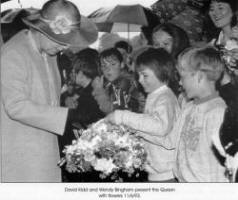 Before 9.30 a.m. the Master rang the bell, we ceased
playing games and lined up in three rows, to enter and take our places
at the desk. The infants were at one end of the big room and the seniors
at the other. The juniors occupied the wee room. There was a partition
in the large room that could be folded back against the wall to leave
the space clear. Large coal fires heated the big room; and a
smaller fire heated the wee room. There was no running water; but we
were never thirsty, an enamel bucket full of cold spring water was
placed on a bench in the cloakroom. A pint tin was beside it, you dipped
it into the water, quenched your thirst, and the remainder was thrown
into the drain, and you replaced the tin. The dry toilets were in a
separate block at the rear of the school. Should it rain, you ran all
the faster: There were compartments without doors, and the wind whistled
through the building, which was kept scrupulously clean. Before 9.30 a.m. the Master rang the bell, we ceased
playing games and lined up in three rows, to enter and take our places
at the desk. The infants were at one end of the big room and the seniors
at the other. The juniors occupied the wee room. There was a partition
in the large room that could be folded back against the wall to leave
the space clear. Large coal fires heated the big room; and a
smaller fire heated the wee room. There was no running water; but we
were never thirsty, an enamel bucket full of cold spring water was
placed on a bench in the cloakroom. A pint tin was beside it, you dipped
it into the water, quenched your thirst, and the remainder was thrown
into the drain, and you replaced the tin. The dry toilets were in a
separate block at the rear of the school. Should it rain, you ran all
the faster: There were compartments without doors, and the wind whistled
through the building, which was kept scrupulously clean.
There was a roll call, and the first subject was
reading. Each lesson lasted 30 minutes and at 10.00 a.m. Mr. Boyd
prepared the attendance board. He chalked in the number of boys and
girls present in each class, and the grand total in the bottom
right-hand corner. The board was hung up for all to see. Religious
instruction was next, and when the Rev. Mitchell took the devotions, we
all sang praises and listened to prayers. The Presbyterians then went
into the wee room, where we had catechism, bible stories and prayers. We
were not always listening to what was being said. We did not know much
about theology, but we did in a clandestine way learn an important tenet
of the Christian faith � the Creed � as it was being recited in the big
room.
Great attention was given to handwriting and Vere
Foster copybooks were used. Written on the top of each page was a
proverb, e.g. "A stitch in time saves nine", "All that glitters is not
gold" and you copied the writing ten times. Having been taught the
correct way to hold your ink pen, that is in your right hand with the
index finger flat along the handle, this gave me some difficulty as I
was left handed (clootie). Never having seen anyone use a pen in their
left hand I persevered.
The subjects taught were arithmetic, geography,
drawing, history, singing, cookery, gardening and physical education.
Geography lessons explained about countries,
mountains, rivers, towns and industries. Maps hung on the wall, and
there was a `globe' with the map of the world on it. The teacher spun it
round to demonstrate how the earth rotates on its axis. But the one
lesson I loved was history, which unfolded the stories of deeds done
long ago. King Alfred burning the cakes. Bonnie Prince Charlie, Robin
Hood, and Francis Drake singeing the King of Spain's beard.
While teaching all subjects a blackboard was used.
Nowadays this is called a `chalk board'. Examples were chalked up, and
they were useful when you have to add up, take away and divide. Tables
were learned by repetition. Ink pots were at the front of the desk and
you had to be careful not to have too much ink on the nib, otherwise you
had blots out the page. Blotting paper was used to soak up excess ink
and there was an art in its application.

The boys did gardening, while the girls learned
cooking. Dressed in white aprons they made soda bread, buns, cakes and
tarts and these were taken home. Mixed aged groups of boys tended plots
in the garden. They dug the plot and planted vegetables. It was a row of
peas, beans, carrots, parsnips, leeks, scallions, parsley and potatoes.
In this way we had practical experience. When the weather was net, we
did theory in the classroom, learning about plants and seeds. There was
a glass jam jar lined with blotting paper and filled with damp sawdust.
Beans were placed between the paper and the glass, and as they
germinated you saw the root sprouting downwards and the shoot growing up
towards the light. Theory was useful knowledge as the garden was a
necessity for survival in what has come to be known as the hungry
twenties and thirties.
Lunch time was 12.30 a.m. � 1.00 p.m. There was no
canteen, so you carried a `piece', which was a sandwich of
sliced batch loaf with jam, cheese or a slice of meat as a filling. It
was wrapped in greaseproof paper and put in a tin. An apple, either sour
or sweet, or a banana was very acceptable. When you were playing games,
you left your `bag' on the ground, and should
anyone sit or stand on it, you had a flat `piece' for lunch. The infants
carried a bottle of milk, as well as a 'piece'. As you got older you did
not bring a bottle, because the other scholars would call you `a big
baby'. The noise we made at playtime could be heard at Culcavey. We
played all those games that need lots of energy. Halftown v. Culcavey at
football, rounders, chasing hide and seek. Hand ball and skipping were
the choice for the girls.
Just like today, we had homework to do, so each
morning you made sure you had your `ecker' with
you. Ten out of ten was what you aimed for, and in your copy-book your
writing had to be `copper-plate' with no blots of
ink on the page. Should your exercise be arithmetic and you found it
difficult, you would 'cog' some other scholar's 'ecker'. In
this case you were fooling no one, only yourself
We were generally drilled in good manners and
behaviour: You respected your elders and spoke when you were spoken to.
Should you wish to leave the room you raised your right hand and asked
the teacher; "Please Miss, may I leave the room?"
Regulations forbade us to go near the Canal, or go
under the bridge or be on the tow path. During playtime as the barges
passed, we waved and cheered, and those on board waved back. At this
school we had kind teachers and pleasant surroundings, among companions.
What better education could you give a child than the one we received
there? With happy memories we were well prepared to journey the pathway
of life."
Our school was beside the Lagan Canal
Master Boyd, Miss Beattie, Miss Baird
Their kindness and skill I can recall
And the words of knowledge I heard.
Pupils on leaving Newport School
Could add and spell, and read and write.
What a golden gift to give a child
To keep for the rest of its life.
Today the age of technology continues its
advancement and the children at Newport have become verycomputer
literate in their work, which continues to be supported by word
processing and internet skills. Emphasis is still very much on the
academic and social aspects of school life. Educational visits continue
but have been extended to destinations further afield such as Euro
Disney in Paris. Visits with other schools through EMU (Education for
Mutual Understanding) links have been established allowing the Newport
children to share their experiences and learning with pupils from other
schools.
The media has also become very much a part of school
life with children taking part in radio interviews and frequently
appearing in local and Province-wide newspapers. Perhaps the most recent
and exciting experience was televised in January 2001, when the entire
school appeared in Ulster Television's School Around the Corner.
The Newport primary seven class of 2000-2001 decided
to try and discover some things about the past of the school, so they
carried out project work asking their parents and grandparents about
their schooldays. Out of eighteen pupils, six had a parent or
grandparent who had attended Newport School � quite a change from the
days when everyone in each generation would have gone to the same
school. Past pupils recalled the various modes of transport to and from
school, which ranged from walking to taking a bus. Many of the former
pupils remembered the teachers by name and also recalled their favourite
subjects. Each person was asked, "Would you like to go back to school
and why?" One ex-pupil responded by saying, "Yes, it would be nice to
try and recapture my youth". It was clear that Newport Primary School
had left many pupils with very happy memories.

ANTHONY'S LOANIN
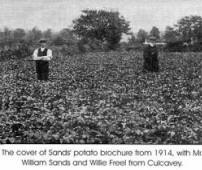 Anthony's Loanin was the colourful name given to the long straight,
narrow road which ran left off Halftown Road just past the old Newport
School. Summerfield Farm was located down this road and its owner,
William E. Sands, was renowned in the field of potato growing. Anthony's Loanin was the colourful name given to the long straight,
narrow road which ran left off Halftown Road just past the old Newport
School. Summerfield Farm was located down this road and its owner,
William E. Sands, was renowned in the field of potato growing.
"World's Record Crops of 1912 and 1913 were
produced from Irish-grown seed potatoes ".
So proclaims a very detailed catalogue of 1914
detailing prize-winning potatoes of every imaginable variety. What all
the potatoes had in common that they were grown from seed produced by
"William E Sands, FRHS, Potato Raiser and Specialist, Hillsborough,
Ireland".
Mr Sands was a resident of Culcavey and his potato
seeds were used the length and breadth of Britain.
His brochure states that "No black scab has been
found in any of the potatoes, which are not grown in or near infested
districts". The catalogue details the entire range of Sands' potatoes
and where they had been exhibited and what awards � and there were many
� they had won. Some of the potatoes rejoiced in splendid names such as
`Sands' Mayflower', `Sands' Erin Queen' and `Sands' Irish Hero'.
There were two farms on the Halftown Road, just past
Anthony's Loanin. A family called Gregory lived there and in the
1920s/30s `Gregory's Buses' provided a service to Belfast each Saturday,
the fare being 6d (2.5 new pence) return. The next farm was Morgan's,
and Lottie's son wrote and performed the song "My Lagan Love".
BERRY'S LANE, SANDY LANE AND MOSS ROAD
Next on the right past Anthony's Loanin was Berry's Lane, so-called
because Mr Berry, a farmer, lived up this lane in Newport Cottage.
Further down the road on the right, past Coronation Gardens, was Sandy
Lane and here six families had homes. Moss Road, which came next on the
left, led to deposits of sand and gravel used by farmers and the
building trade up until 1939. To facilitate the building of Long Kesh
aerodrome during the Second World War, the government requisitioned the
land from Anthony's Loanin to Bog Road, left side of the Halftown Road.
CORONATION GARDENS
David Adams has provided an insight into the history, people and life of
the area.
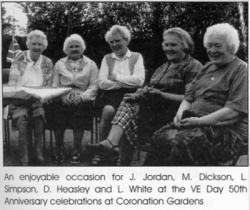 The main centre of population at the Lower Maze is
Coronation Gardens, which was built as a public housing estate in 1950
and consists of 60-plus houses. The "Coronation" prefix in the title of
the housing estate reflects not only the era when it was built but also
largely the political affiliation of its inhabitants. Adding to the
local populace a much smaller private housing development, Florence
Court, was built alongside in the early I 970s � but essentially "the
Gardens" remains at the heart of the area. Built roughly in the shape of
a half-moon, Coronation Gardens sits on one side of the Halftown Road
and faces across the road onto the Lower Maze Community Hall � formerly
Lower Maze I 1 I Orange Hall. Beyond the community hall lies the
343-acre site of the former Maze Prison and Long Kesh army base. The main centre of population at the Lower Maze is
Coronation Gardens, which was built as a public housing estate in 1950
and consists of 60-plus houses. The "Coronation" prefix in the title of
the housing estate reflects not only the era when it was built but also
largely the political affiliation of its inhabitants. Adding to the
local populace a much smaller private housing development, Florence
Court, was built alongside in the early I 970s � but essentially "the
Gardens" remains at the heart of the area. Built roughly in the shape of
a half-moon, Coronation Gardens sits on one side of the Halftown Road
and faces across the road onto the Lower Maze Community Hall � formerly
Lower Maze I 1 I Orange Hall. Beyond the community hall lies the
343-acre site of the former Maze Prison and Long Kesh army base.
Before Long Kesh internment camp, later to become HMP
Maze, was constructed, the surrounding area was exclusively of a rural
agricultural nature. A small section of the local populace found
employment with farmers in the area, but, in the main, most people
travelled the three miles to Lisburn to work.
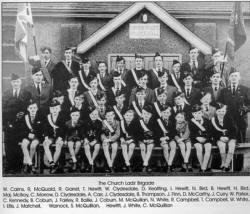 The focal points of community activity were Newport
Primary School, Lower Maze 111 Orange Hall (now Lower Maze Community
Hall) and Eglantine Parish Church. Two local pubs, Drake's and Mills'
(now Gowdy's), which are still in existence and a local shop, Palmers,
(now gone) also provided for the area. With Eglantine Parish Church
having no church hall at that time, Lower Maze Orange Hall was the venue for meetings of the Church
Lads Brigade, and in later years Halftown Residents' Association and the
local Youth Club. The focal points of community activity were Newport
Primary School, Lower Maze 111 Orange Hall (now Lower Maze Community
Hall) and Eglantine Parish Church. Two local pubs, Drake's and Mills'
(now Gowdy's), which are still in existence and a local shop, Palmers,
(now gone) also provided for the area. With Eglantine Parish Church
having no church hall at that time, Lower Maze Orange Hall was the venue for meetings of the Church
Lads Brigade, and in later years Halftown Residents' Association and the
local Youth Club.

The present site of the now-closed Maze Prison was
commonly referred to as "The Camp" and housed nothing livelier than a
few straggly sheep and a meteorological station from where weather
balloons would be released periodically. The sheep, owned by local
farmers who leased the land for grazing, didn't always confine
themselves to the boundaries of the camp but often wandered at will
along the adjoining Halftown Road.
Another, and for the local children at least, far
more interesting lessee at the camp was a gliding club. Indeed, on the
occasional Sunday afternoon during the summer months, people who had
travelled out from Lisburn would often join with local children and
adults to watch the gliders taking off and landing.
Another local venue that was capable of attracting
people from a much wider dispensation was the Maze Racecourse (now Down
Royal). Although in those days horse racing at the Maze took place on a
far more infrequent basis than now, it still attracted people from the
length and breadth of Ireland and beyond. Not surprisingly it also
attracted the people from the Maze itself. Young and old alike, mostly
male of course, used to walk the couple of miles from the Lower Maze
once or twice a year to enjoy the racing. The men went for the racing
and a few pints of beer at Mills' pub next door to the racecourse and
the youngsters for the colour and excitement of the day. The many
multi-decorated stalls selling everything from candyfloss and toffee
apples to windmills and kites proved irresistible to every child within
walking distance.
Other than on special occasions such as the Maze Races, entertainment
and social activity was largely self-generated. Pigeon racing has always
been very popular in the area and an occasional card school or game of
pitch-and-toss wasn't unheard of in years gone by. Remembering a
childhood spent at the Lower Maze is to remember skipping, hopscotch,
rounders, hide-and-seek, chasing, the Queen of the May and girls playing
numerous complicated ball games against gable walls. Strangely as it
seems now, where the boys were concerned at least, there was also a
seasonal or cyclical dimension to the playing of games. For a time
marbles would be all the rage and then, almost unspoken, everyone would
begin to play bows and arrows for a while, then, just as unannounced,
these would be put aside for the building and racing of guiders or
playing with hoops or old tyres. Eventually, everyone would return to
marbles and the cycle would begin again.
A sparsely populated area, the Lower Maze at that
time was much like any other rural area in Northern Ireland. People
tended to gravitate towards their local church much more than they do
nowadays. Travel beyond the area, either to Lisburn or Hillsborough, was
invariably done on foot or by the twice a-day bus service. Car ownership
was viewed as a distinct luxury and the use of taxis an almost unheard
of over-indulgence. Consequently, although the Lower Maze area is still
quite rightly viewed as a relatively tight knit community, in this
respect at least, it is as nothing to how it was then. In those days
almost all social activity and interaction by adults and children alike
was carried out in the immediate area. Adults ventured beyond the area
merely to work or for shopping. A child's first experience of a world
beyond the Maze was his or her first day at secondary school. Other than
this the main reference points for life in general were all anchored at
the Maze.
One can begin to imagine then, the cultural shock to
a small rural community such as the Maze with the development, literally
on their doorstep, of what was quickly to become the most famous � or
infamous � prison in the world. When Long Kesh internment camp, and
later HMP Maze, was sited at Lower Maze, "the troubles", which
previously had seemed so distant, became an overnight reality and
constant companion of the people of the area. A constant flow of prison
visitors, increased security, periodic protests by political and
paramilitary groupings and massive media interest suddenly became the
norm. The area and its inhabitants were catapulted into a spotlight they
neither wanted nor deserved. As the years went by the disruption to
normal life increased. The burning of the prison by its inmates, a mass
breakout by republicans, the dirty protest and hunger strike, plus
numerous small incidents, all combined to create an almost siege-like
atmosphere at the Lower Maze. This ebbed and flowed with political
development and at particular times in the prison's history. All of this
took place against a constant backdrop of the high security measures and
safeguards in place. Helicopter traffic night and day, sirens blaring
and lights blazing, security checkpoints and army patrols were all a
continuing reminder of the potential risks in living in such close
proximity to the prison. With the closure of the prison, the area looks
set to experience substantial change yet again.
Despite pressures imposed on the community, the area
remains close-knit and forward-looking and the best recent evidence of
this is the construction of the new Lower Maze Community Hall.
built at the instigation of local people and involving a high
level of co-operation.
A good indicator of how the people of Lower Maze feel
about their area is the fact that family names and connections have
remained largely static. Names like Fay, Mallon, McKeown, Welsh, Heasley,
Quinn, Campbell, Patton, Martin, McQuillan, Cargo, Stewart, Kennedy,
Coburn, Bird, Willis, White and Lavery are synonymous with the area.

LOWER MAZE COMMUNITY HALL
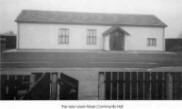 The Downshire Family built Lower Maze Orange Hall in the year 1810 as a
National School. When Newport Public Elementary School was built the
hall became an Orange Hall shared by Singleton's Lodge LOL Ill and
Chapman's Lodge LOL No 244. LOL 244 ceased to function around about
1923, leaving LOL 11 l in control. The Lower Maze Orangemen made a big
contribution towards the cost of building Newport School in the year
1877. The Downshire Family built Lower Maze Orange Hall in the year 1810 as a
National School. When Newport Public Elementary School was built the
hall became an Orange Hall shared by Singleton's Lodge LOL Ill and
Chapman's Lodge LOL No 244. LOL 244 ceased to function around about
1923, leaving LOL 11 l in control. The Lower Maze Orangemen made a big
contribution towards the cost of building Newport School in the year
1877.
Apart from being used in the early 1900s as a Sunday
School, the hall provided the meeting place for the Church Lads' Brigade
Company. Eglantine Company was part of the 3rd Battalion of the Church
Lads' Brigade.
The first Commanding Officer was Mr Jack Curry and
Officers were William Parker, Dougie McCarthy, George Quail, Noel Finlay
and Foster Cottney. It was a large contingent and the boys enjoyed the
marching, drilling, gym work, singing, hand ball, 5-a-side football,
cross country running and religious education. The annual summer camps
were looked forward to, visiting such places as Bangor, Ballycastle,
Portstewart, Morecombe, St. Anne's on Sea, and Ramsey, Isle of Man. Over
the years numbers declined and the company is no longer operating.
The formation of the Halftown Residents Association
brought new life in the use of the Hall. It was realised that in order
to meet the needs of the community serious remedial work would need to
be done to bring the Hall up to standard. The project kicked off in
1996, when the local community initiated a fund-raising drive. The
Halftown Residents Association successfully
approached Lisburn Peace and Reconciliation for a substantial grant to
carry out repairs to the existing hall. However, a subsequent
professional survey revealed that somewhere in the region of �90,000
would be required to bring the existing hall up to basic standards for
community use. At that stage it was decided that a more viable option
would be to build a completely new hall on the existing site. In order
to take the project forward a Community Hall Management Committee was
formed.
Together with funding from Lisburn Borough Council,
Lisburn Peace and Reconciliation, and the Millennium Halls Fund, plus
hard work and the assistance of many people, the dream of a modern
community hall became a reality. The whole project would not have become
a reality without the help of the Officers and Members of Lower Maze LOL
III, who with their generosity and understanding gave the community a
place to be proud of. The official opening of Lower Maze Community Hall
took place on 4th December 2000.

THE LOYAL ORDERS
THE ORANGE ORDER
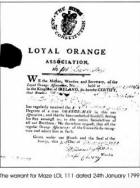 The district has a prominent association with the Orange Order, not
least the Blaris and Lower Maze areas. The Battle of the Boyne needs no
re-telling. An entry in the Vestry Book of the Cathedral of Lisburn
states that King William III and his army marched through that town in
1690, and encamped at Blaris, on his way to the Boyne, but did not stop
there, as he proceeded to Hillsborough. The camp at Blaris was situated
on the farm owned by William Fullerton. His home was called Camp Lodge
in memory of its past history. A Doctor Cupples (then Rector of the
Parish of Lisburn, alias Blaris) was called on to visit a parishioner
named Connor who had seen King William alight from his horse and throw
the reins over a bush for a short halt. This bush was then known as the
King's Bush, and was still to be seen on the road to Blaris graveyard
until the middle of the nineteenth century. Connor, ancient inhabitant
of Blaris, died at the age of 110. The district has a prominent association with the Orange Order, not
least the Blaris and Lower Maze areas. The Battle of the Boyne needs no
re-telling. An entry in the Vestry Book of the Cathedral of Lisburn
states that King William III and his army marched through that town in
1690, and encamped at Blaris, on his way to the Boyne, but did not stop
there, as he proceeded to Hillsborough. The camp at Blaris was situated
on the farm owned by William Fullerton. His home was called Camp Lodge
in memory of its past history. A Doctor Cupples (then Rector of the
Parish of Lisburn, alias Blaris) was called on to visit a parishioner
named Connor who had seen King William alight from his horse and throw
the reins over a bush for a short halt. This bush was then known as the
King's Bush, and was still to be seen on the road to Blaris graveyard
until the middle of the nineteenth century. Connor, ancient inhabitant
of Blaris, died at the age of 110.
Ireland entered a state of comparative
tranquillity after the Boyne until 1793, when radical movements began to
make themselves felt in the country, chiefly as a repercussion of the
French Revolution. On 10th May 1795, three months previous to the
formation of the first proper Orange Lodge, the Association of United
Irishmen was formed and a committee of delegates met at Belfast and
completed their constitution. The Protestant people banded themselves
together against this pressure. They became true to their sovereign,
steady in their faith, and united for the purposes of defence. They made
loyalty the pledge of their union and dedicated themselves to maintain
the principles of that constitution for which their ancestors had bled.
They assumed the name of him whose memory they held in highest esteem;
they called themselves The Loyal and Religious Orange Institution'. The first
lodge properly constituted under this new title was established at Dyan,
a beautiful village on Lord Caledon's estate in County Tyrone. Some
records show that in Loughgall after the Battle of the Diamond on 21st
September 1795, in a certain Dan Winter's cottage (subsequently burned),
yeomen from various districts, including three from Lisburn, met for the
purposes of allocating warrants for other lodges of the new Orange
Institution. In fact it appears that the warrants were issued from the
house of James Sloan, who himself signed the early warrants. One of the
men from Lisburn to whom a lodge number was allocated was William
Singleton, domiciled at Lower Maze, and to him went the number of Lower
Maze Lodge No. 111. In Orange history this is unique, since there are
also lodges bearing this number in Cookstown and Newtownards, Lower Maze
LOL No.111 was therefore begun in 1795, and was one of the foremost
lodges in the Orange Institution.
The oldest document found, dated January 1799,
reveals William Singleton as Worshipful Master of the Lodge, with
William Joseph Cherry as Warden. Thomas Wilson is described as
Secretary, and Henry Toan as a Candidate. The lodge sat in a house owned
by Thomas Garrett. Something is known about these persons and their
families. A Thomas Singleton was churchwarden in Magheragall Parish
Church in 1666 (and extracts from the Hertford Estate papers reveal him
paying hearth tax in that year). In 1719 a George Singleton (grandson of
Thomas) owned 147 acres of land and paid an annual lease of �15 Os 4d.,
while in 1726 Silas (connection unknown) was charged a rental of �9 41s
3.5d. for land. George Singleton had a lease granted in 1756, Silas in
1787, and John Singleton likewise in 1790. There is every reason to
suppose then that the Magheragall Singletons had a very close
relationship with the Maze Singletons, if not a direct lineage. Indeed,
in Magheragall Churchyard lies a white marble headstone with the
inscription `William Singleton, Lower Maze, 1844' � in all likelihood
here lies the remains of the first Master of Lodge 111, Lower Maze.
The Cherry family are of Huguenot descent � and the
name now a diminutive of De Cherrie, or de la Cherrois, or, as known in
Lisburn, Delacherois. In the history of the early Methodist Church in
Ireland there is mention of two brothers Cherry who were connected with
the Zion Methodist community at Priesthill, and whose residence is given
as Lower Maze. At any rate, our Joseph Cherry was one of the thirty-two
men who rebelled against the governing Methodist body. There is mention
of his being brought before the King's Camp at Blaris, but being a man
of high standing in the community was immediately released. The Cherry
family figures prominently in the title papers of the Kilwarlin Estate
Rental Register and John Cherry leased land in Maze in 1756, whilst
Moses Cherry did the same in 1789. This register (1801-1804) reveals the
names of families whose descendants still live within the area. Under
Carnbane is listed John Leathem, leasing granted in 1756, and John
Hancock of Carnbane House was granted land in the same year. Under Culcavey is listed Sir G Atkinson; under Maze Hugh
and John Morgan, with Silas and John Dickson, claiming land in 1789;
William McCoy and William Quaile and David Quaile with James Phenix,
William Phenix and Andrew Briggs are all listed as rent-paying in the
middle of the 18th century. For Ravarnet in 1771 is listed McKee and
William and Susan McLoran. Many of these names are still linked with the
area.

 Henry Toan, the candidate mentioned in the 1799
document, resided at Ballentine, quite close to the king's camp at
Blaris. Thomas Wilson, the first secretary of Lodge 111, is credited
with drawing up certain signals by which Orangemen were enabled to recognise one another. He was probably related to
James Wilson, the 1794 Orange hero, and one of the original members of
the Orange Boys of that year. Abraham, son of James Wilson, recounted
that his father had penned an early Orange history, though no trace of
it can now be found. A former Town Clerk of Lisburn, Mr. T.M. Wilson,
was also a descendant of the family. Henry Toan, the candidate mentioned in the 1799
document, resided at Ballentine, quite close to the king's camp at
Blaris. Thomas Wilson, the first secretary of Lodge 111, is credited
with drawing up certain signals by which Orangemen were enabled to recognise one another. He was probably related to
James Wilson, the 1794 Orange hero, and one of the original members of
the Orange Boys of that year. Abraham, son of James Wilson, recounted
that his father had penned an early Orange history, though no trace of
it can now be found. A former Town Clerk of Lisburn, Mr. T.M. Wilson,
was also a descendant of the family.
Of the Thomas Garrett in whose house the Lodge first
sat, little definite is known. A certain Lieutenant Robert Garrett
served in the Magheragall Yeomanry founded in 1793, the same year as the
famous South Down Militia was brought into being by an Act of the Irish
Parliament. The Garrett family was all engaged in the cloth business in
the Magheragall area. The Garrett name is still associated with the
Coronation Gardens area of Lower Maze.
In 1810 the Downshire Family built a National School
at Lower Maze and when Newport Public Elementary School was built the
building became an Orange Hall shared by Singleton's Lodge LOL 1 1 1 and
Chapman's Lodge LOL No 244. LOL 244 ceased tofunction around about 1923,
leaving LOL 1 I 1 in control. The Lower Maze Orangemen made a big
contribution towards the cost of building Newport School in the year
1877.
A thriving community in the Lower Maze area brought
about the formation of Lower Maze Community Group. This group has
achieved a great deal, including the construction of a new community
hall on the site of the old LOL 111 Orange Hall.
A continuous list of past Masters of LOL 1 l I exists
and can be traced back to 1799:
|
1799 |
|
William
Singleton |
|
1866 |
1864 |
Michael
McCullough |
|
1869 |
1874 |
Harry
Houston |
|
1875 |
1880 |
Isaiah
Singleton |
|
1881 |
1882 |
Harry
Parkinson |
|
1883 |
1887 |
Silas
Singleton |
|
1888 |
1893 |
Joseph
Adams |
|
1894 |
1919 |
William
Watson |
|
1920 |
1926 |
Thomas
McCarthy |
|
1927 |
1934 |
Thomas
Singleton |
|
1934 |
1937 |
Joseph
McCarthy |
|
1938 |
|
A. McClure |
|
1939 |
1946 |
Thomas
Singleton |
|
1947 |
1950 |
David
Stevenson |
|
1951 |
|
William
Steele |
|
1954 |
1955 |
Thomas
McCarthy |
|
1956 |
1957 |
Richard
McCarthy |
|
1958 |
1959 |
Albert
Singleton |
|
1960 |
1961 |
John Curry |
|
1962 |
1964 |
William
Smyth |
|
|
1965 |
|
William
Lyttle |
|
1966 |
1967 |
Thomas
Beckett |
|
1968 |
1969 |
John
Dickson |
|
1970 |
1971 |
Peter Ward |
|
1972 |
1973 |
James
McQuade |
|
1974 |
1975 |
John
Singleton |
|
1976 |
1977 |
Leonard
Crossey |
|
1978 |
1979 |
David Bell |
|
1980 |
1981 |
James
McQuillan |
|
1982 |
|
Stephen
Bird |
|
1983 |
1984 |
Adrian
McCutcheon |
|
1985 |
1986 |
Maurice
Heron |
|
1987 |
1988 |
James
Thompson |
|
1989 |
1990 |
Ivan Spence |
| 1991 |
1992 |
Brian
Coburn |
|
1993 |
1994 |
Harold Wilson |
|
1995 |
1996 |
John Lawrence |
|
1997 |
1998 |
Keith Armstrong |
|
1999 |
2000 |
Mervyn McIlroy |
| 2000 |
|
Bertie
Petty |
|

LOWER MAZE SCARLET
KNIGHTS ROYAL BLACK PRECEPTORY No. 124
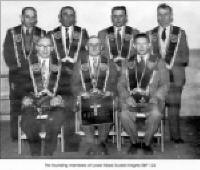 The new preceptory was inaugurated in Lower Maze Orange Hall on
Tuesday 31st January 1961, when representatives from counties Antrim,
Down and Belfast were present. The new preceptory was inaugurated in Lower Maze Orange Hall on
Tuesday 31st January 1961, when representatives from counties Antrim,
Down and Belfast were present.
Wor. Sir William Kain, Imperial Deputy Grand Master,
presided, assisted by Wor. Sir Knt. John Patton, Worshipful District
Master of Lisburn RBDC Nol. Included guests were Wor. Sir Knts. S.J.
Kerry, County Grand Master of Down, William J. Warnock, DDM Nol,
Belfast, and John Stewart, DDGM. Wor. Sir Knt. Kain, in handing over the
warrant gave a brief outline of its history.
The warrant was first issued to be held at Liverpool
on 17th June 1857, in which year Sir Knt. William Johnston of
Ballykilbeg became Sovereign Grand Master of the then Grand Black
Chapter of Ireland, a position he held until his death in 1902. On 1st
June 1894 the warrant was surrendered and cancelled. It was re-issued to
be held at Plumstead, Woolwich (Kent) on 11th July 1895 and became
dormant in 1900 and was `not accounted for' until 1908. On 16th December
1908 it was re-issued in the name of Moses Sefton, to be held at Bootle,
Liverpool. The warrant was surrendered and cancelled on 13th June 1950.
The warrant ended its career in England when it
became dormant in 1943. The title of the warrant then was `Knights of
Enniskillen'. On 2nd December 1960 it was re-issued to be held at Lower
Maze, with the title of "Lower Maze Scarlet Knights".
After the inauguration ceremony Sir Knt. John Curry
opened the new preceptory and invited Wor. Sir Knt. Kain to take the
chair and conduct the installation of their new Officers of the
Preceptory, of which the following were installed: W.M. Sir Knt. John
Curry; D.M. Sir Knt. James Sinnerton; Chaplain Sir Knt. William
McCambley; Registrar Sir Knt. John Richmond; Treasurer, Sir Knt. William
Smyth; Pursuivant Sir Knt. Thomas Morgan; Foreman of Committee Sir Knt.
John Morgan.
The first banner was second-hand, a gift from the Sir
Henry Wilson Memorial RBP 1194, and the first `Last Saturday in August'
demonstration for the new preceptory was held in Antrim. The story is
told that this banner was in such a poor state of repair it had to be
stuck together with tape, which began to peel off in the rain at the
demonstration in Antrim. A press photograph appeared in the newspaper
and in the reflection of the light the banner appears as new!
The preceptory's first new banner, depicting
Eglantine Parish Church and the `Escape of the two spies', was unfurled
on 4th August 1962. The second, and present banner, was dedicated by
Rev. Sir Knt. WJF Moore, Deputy Grand Chaplain of Down, on Friday 28th
May 1982. Wor. Sir Knt. David Bell, Worshipful Master, presided and the
unfurling ceremony was carried out by Wor. Sir Knt. Peter Ward, PM RBP
124, Worshipful District Master, Lisburn RBDC No.I.
In its relatively short history the preceptory has
taken an active role within Lisburn Royal Black District
Chapter, having provided four Worshipful District Masters: Peter Ward
1980-1981; John Burleigh 1986-1987 (who for a period was Imperial Grand
Registrar and also an Assistant
Sovereign Grand Master, and IDGM � now transferred to
Lyons royal Knights RBP 452); William McCambley 1990-1992 and John Curry
1996-1998. The latter two were our foundation members.
Wor. Sir Knt. William McCambley, having decided to
take up lecturing, gained his Lecturer's Certificate on 31st March 1962
and was nominated 2nd District Lecturer shortly thereafter. On the
resignation of Wor.Sir Knt. William Dalzell from the Institution, Wor.
Sir Knt. McCambley took over the mantle of I st District Lecturer,
travelling to various preceptories within Lisburn District and other
neighbouring districts. In this capacity he has been responsible for the
initiation of literally hundreds of Sir Knights into our institution,
and although now retired from district office he continues to confer
degrees in several preceptories.
The preceptory continues to flourish, and while we
miss our old home we are delighted to be associated with the new
Halftown 2000 Hall, and wish the management every success, and look
forward to many more years at Lower Maze

MRS. ELIZA McGUIGGAN
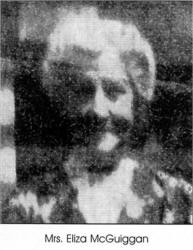 The loyal orders in the area used the skills of Newport woman, Mrs Eliza
McGuiggan. She had a reputation for creating beautiful banners, and this
expertise was acknowledged by a local newspaper by an article about her
work. This article is quoted below. The loyal orders in the area used the skills of Newport woman, Mrs Eliza
McGuiggan. She had a reputation for creating beautiful banners, and this
expertise was acknowledged by a local newspaper by an article about her
work. This article is quoted below.
When County Down Blackmen parade through Comber for
their "Last Saturday" demonstration, a fitting memorial to
the skill of a Lisburn woman in the form of the Blacskull Sir Knights'
banner will continue to be a centre of attraction. The banner was
hand-embroidered more than 60 years ago by the late Mrs. Eliza McGuiggan
and is the last known example of her expertise.
Mrs. McGuiggan, whose cottage home at Newport, near
Sprucefield, was demolished to make way for the Ml,
embroidered numerous flags and table centres for the Orange, Black and
Masonic Orders. Later she converted many of these into banners.
Until recently, the banners of Quilly (Dromore) and
Pond Park (Lisburn) Royal Black Preceptories were still in use and now
occupy a place of honour in the respective meeting places. But the
Blackscull men continue to walk behind the banner macle for them in 1915
by Mrs. McGuiggan at a cost of approximately �7.50. Present clay banner
prices range between �400 and �600!
The first example of the work of Mrs McGuiggan, who
died 17 years ago at the age of 98, was in ca sash (the old-style type),
apron and garter for her husband, Mr David McGuiggan, a Past Master of
Broomhedge RBP 244. Mr. McGuiggan died in 1925 at the age of 62. Mrs
McGuiggan's first banner was for Halftown (Lower Maze) LOL No 111. The
material which she used was American silk purchased from the Bank
Buildings in Belfast.
Mr & Mrs McGuiggan had five children � three sons,
Levi (Lisburn), Victor (Coventry) and David (Portadown) and two
daughters � the late Mrs Lily Kinkaid (Lurganure) and the late Miss
Maggie McGuiggan. Mr Levi McGuiggan, whose home is at 69 Gregg Street,
has many memories of his mother's painstaking work on the banners and
regalia. "I believe the Blackskull banner unfurled about 1915, was my
mothers last major piece of embroidery. Although some lodges and
preceptories still have new banners embroidered, I'm afraid it's a
fading craft. There is no one in our family to carry on the tradition ",
he said.
LAMBEG DRUMS
There has been a long association, and an avid following, of the Lambeg
Drum in the area. In years gone by the drumming season was represented
by the sound in the distance of the beat of the drums. Close to home it
was much louder, and while many a person would call it `batter, batter',
the Lambeg drummers would cock their ear and listen to the `tune'. The
`tunes' had many names `Pigeon on the Gate', `Beggar man' etc., and a
discerning person would recognise these. Even today if you watch the
Lambeg drummers, two people beating different drums, their rhythm and
beat match exactly, even though they can't hear each others `tune'.
Lower Maze LOL 1 l I had, and still retains, in its
possession two drums � one of which is called `The Darkie'. Years ago in
Culcavey, Stewarty Walker would line up `The Horse', `The Duke' and the
`Culcavey Champion'. A lot of hard work went into the `pulling' of these
drums (not like the easy way today with a machine to do the work). Two
men sitting on a bench with the drum in front of them `tightening the
ropes'.
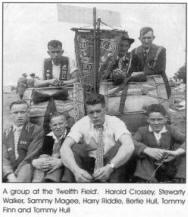 Culcavey corner was the learning place for many of
the young men interested in the drums. Names like Crossey, Patton,
Wilson, McCarthy, Hull, Campbell, Finn, Hewitt, Riddel - young hands and
old - spring to mind, but there were many more. The `Eleventh Night' was
as important as the `Twelfth Day'. The drums were pulled to `bursting
point' (and many did) then they proceeded up to Hillsborough, playing
all the way, to rendezvous at Ritchies' pub. Here everyone who wanted
could have a tune on the drum, and at pub closing time it was about-turn
and back down the road to Culcavey, playing all the merrier. Their
arrival back home usually coincided with the lighting of the bonfire, an
event looked forward to by young and old. The `Twelfth morning' had them
doing the whole thing all over again, although on this occasion all were
dressed in their best and the drums were dressed too with Orange Lilies. Culcavey corner was the learning place for many of
the young men interested in the drums. Names like Crossey, Patton,
Wilson, McCarthy, Hull, Campbell, Finn, Hewitt, Riddel - young hands and
old - spring to mind, but there were many more. The `Eleventh Night' was
as important as the `Twelfth Day'. The drums were pulled to `bursting
point' (and many did) then they proceeded up to Hillsborough, playing
all the way, to rendezvous at Ritchies' pub. Here everyone who wanted
could have a tune on the drum, and at pub closing time it was about-turn
and back down the road to Culcavey, playing all the merrier. Their
arrival back home usually coincided with the lighting of the bonfire, an
event looked forward to by young and old. The `Twelfth morning' had them
doing the whole thing all over again, although on this occasion all were
dressed in their best and the drums were dressed too with Orange Lilies.
This tradition continued on after the demise of
Stewarty, with his son Jimmy following in his footsteps. Jimmy was a
familiar picture in the village, sitting on a bench outside his house at
15 Hillside Terrace (the corner). He, like his father, was `good craic',
and a practical joker. To give an example, one night he lifted an old
rubber backed carpet out of his living room and took it round the side
of the house, turned it upside down, the black coating showing, and
planted artificial flowers through it. The next morning he sat on the
bench as usual and grinned happily as people passing congratulated him
on the lovely flowers growing in the garden. This was in the middle of
winter and he had a `quire' laugh!
The Lambeg drumming tradition `at the corner' stopped
after Jimmy died, but the event was marked one more time. On the last
`Eleventh Night' before the row of houses was demolished, the drums
again beat out their `tune' at 15 Hillside Terrace played by Jimmy's two
nephews (Stewarty's grandsons).

THE FLUTE BAND
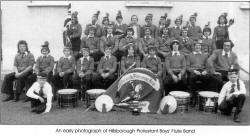 In every town or village in N. Ireland there is at least one flute band,
and our area is no exception. The formation of Hillsborough Protestant
Boys' Flute Band came about in June 1974 led by Eric McCallister and
David Chambers, with the help of Geoffrey Gibson, Minis and Joe Flanagan
from Pride of Down (Dromore). The first band practice took place over 26
years ago. At that time they practised in Magheradarten Hut on the
Ballynahinch Road, Hillsborough, sitting on wooden benches on the cold
winter nights round a pot belly stove learning to play the flute and
drums. Jackie McQuillan was at that first practice and today continues
to play, influence and guide the Band. The first Band parade was on 12th
July 1975. When the Band first came into being it was enthusiastically
supported and had a high membership. The Band uniform then consisted of
a Glengarry cap costing �10, an orange and purple Jumper costing �5.50,
and members were required to supply their own white shirt, black school
trousers, and a purple dickie bow costing 75p. A Miller brown flute
purchased at that time cost �13.50. Today the latest new uniform
purchased cost �259 and a flute was �85. So there is also inflation in
the music business! In every town or village in N. Ireland there is at least one flute band,
and our area is no exception. The formation of Hillsborough Protestant
Boys' Flute Band came about in June 1974 led by Eric McCallister and
David Chambers, with the help of Geoffrey Gibson, Minis and Joe Flanagan
from Pride of Down (Dromore). The first band practice took place over 26
years ago. At that time they practised in Magheradarten Hut on the
Ballynahinch Road, Hillsborough, sitting on wooden benches on the cold
winter nights round a pot belly stove learning to play the flute and
drums. Jackie McQuillan was at that first practice and today continues
to play, influence and guide the Band. The first Band parade was on 12th
July 1975. When the Band first came into being it was enthusiastically
supported and had a high membership. The Band uniform then consisted of
a Glengarry cap costing �10, an orange and purple Jumper costing �5.50,
and members were required to supply their own white shirt, black school
trousers, and a purple dickie bow costing 75p. A Miller brown flute
purchased at that time cost �13.50. Today the latest new uniform
purchased cost �259 and a flute was �85. So there is also inflation in
the music business!
The Band has remained in business where other larger
contingents have since wound up. This may be due to the fact that the
members are mainly from the local community and although considered a
small Band in the fraternity, the main aim has been the enjoyment of
music. Members came from Hillsborough, Culcavey, Coronation Gardens,
Long Kesh (now Eglantine) and Ravarnet, with a few from Lisburn. Most of
the members walked to Band practice and one member, Paul Walker, was
killed as he made his way up along the dual-carriageway.
The Band has played and paraded all over N. Ireland
and Scotland, and has close association with LOL 144, Hillsborough
District 19, Hillsborough Apprentice Boys and Royal Black Preceptory.
At its largest membership the Band had 32 Fluters, 8
Side Drummers, 2 Cymblers, 2 Road Marshals, 3 Flag Girls and 2 Leaders.
Today the numbers have dropped to 15 Fluters, 6
Side Drummers, 2 Cymblers, I Road Marshal, 3 Flag
Girls and I Leader. The fall in numbers may be associated with a loss of
interest in music and the advent of the computer (which occupies the
time of the younger generation). As long as there are young people out
there who want to come to the Band and to learn to play instruments
there will be someone there to teach them and encourage them to continue
our culture and tradition in the area.
 |